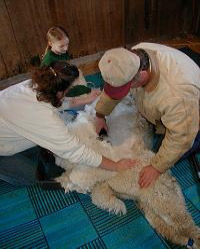Shearing Alpacas

Author: GLAA member Kara Heinrichs of Ann Arbor Alpacas
kara@annarboralpacas.com
Throughout the United States, alpacas are generally shorn once a year.
Because of the high summer heat and humidity common in the Great Lakes
region, most Great Lakes breeders shear in April, May, and June. Alpacas
are fiber animals and are being bred up every year to exhibit denser
fiber so heat stress is a very real and deadly danger for them. Barrel
cuts can be OK (clipping only the fiber around the middle of the
animal), but most Great Lakes breeders prefer to remove all or most of
the fiber if possible. When shorn, each animal yields 5 to 10 lbs of
fiber per year (2.5 to 7 pounds of prime fleece and 2.5 to 4 pounds of
seconds). Some owners do their own shearing, but many hire professional
shearers to come to the farm. Different owners and shearers also have
different shearing preferences. Alpacas can be shorn laying down (much
as sheep are shorn) or standing up (much as llamas are shorn). Both
approaches have their advantages and disadvantages. The real key is to
do whatever creates the least stressful experience for your alpacas
(especially pregnant females) while producing the highest quality clip
with the highest yield and lack of second cuts.
The clip is sorted and bagged and then either stored for later
processing or sale or sent directly to a fiber co-op or mill. Sorting
the clip involves separating the blanket, also called the prime (the
fiber from the sides and back of the animal, which is the highest
quality), from seconds (neck and bib fiber generally, which can be
shorter and/or coarser than the blanket) from thirds or discards (the
fiber from the legs, tail, and belly, which is generally not usable in
garments and is discarded by many breeders or used in other ways). Care
and preparation of the animals prior to shearing is the key to getting
good quality fiber off of the alpaca. Each animal has a genetic
potential for producing fiber of a certain quality and color, but the
specific fiber production (actual quality and quantity) is directly
affected by nutrition, climate, and overall health. The value of the
fleece is additionally affected by its cleanliness, especially the
absence of vegetable matter like sticks and straw and dung. Most
breeders don’t wash animals prior to shearing (unless someone has had an
especially big roll in a mud puddle). Unlike sheep, alpacas don’t have
lanolin or other heavy oils in their fiber which means that it’s usually
enough to shake out the dust and pick out any debris from their fleeces
before shearing. It’s also uncommon to brush animals before
shearing–brushing pulls out fibers and disturbs the “lock structure.”
Instead, various means like vacuums or cool blowers or beating wands are
used to shake or pull out dust and as much debris as possible. Since
most animals will only put up with this sort of prep for so long, the
fleece can be further picked clean once it’s removed from the animal.
Many breeders use skirting tables (mesh surfaces that dust and debris
can fall through) to lay out the fleeces and finish the cleaning.

